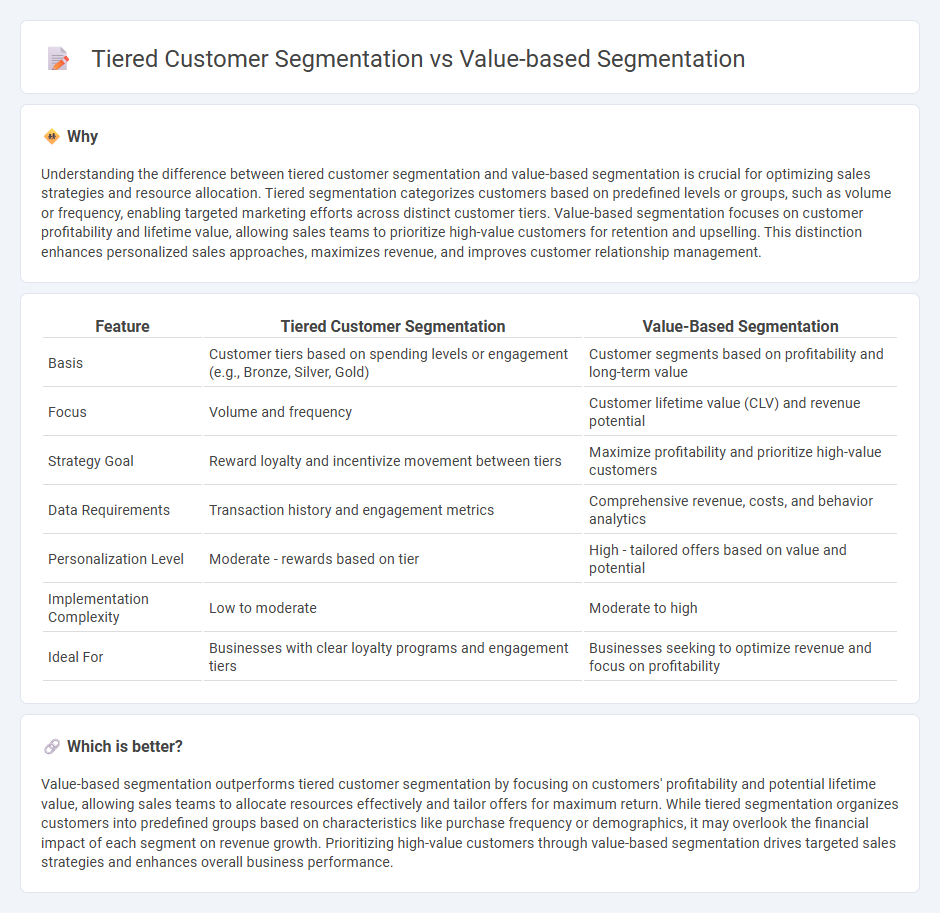
Tiered customer segmentation categorizes clients into distinct levels based on predefined criteria such as purchase frequency or volume, allowing targeted marketing strategies for each tier. Value-based segmentation focuses on the profitability and long-term value of customers, prioritizing resources to maximize revenue from the most valuable segments. Discover how integrating these approaches can optimize your sales strategy and enhance customer engagement.
Why it is important
Understanding the difference between tiered customer segmentation and value-based segmentation is crucial for optimizing sales strategies and resource allocation. Tiered segmentation categorizes customers based on predefined levels or groups, such as volume or frequency, enabling targeted marketing efforts across distinct customer tiers. Value-based segmentation focuses on customer profitability and lifetime value, allowing sales teams to prioritize high-value customers for retention and upselling. This distinction enhances personalized sales approaches, maximizes revenue, and improves customer relationship management.
Comparison Table
| Feature | Tiered Customer Segmentation | Value-Based Segmentation |
|---|---|---|
| Basis | Customer tiers based on spending levels or engagement (e.g., Bronze, Silver, Gold) | Customer segments based on profitability and long-term value |
| Focus | Volume and frequency | Customer lifetime value (CLV) and revenue potential |
| Strategy Goal | Reward loyalty and incentivize movement between tiers | Maximize profitability and prioritize high-value customers |
| Data Requirements | Transaction history and engagement metrics | Comprehensive revenue, costs, and behavior analytics |
| Personalization Level | Moderate - rewards based on tier | High - tailored offers based on value and potential |
| Implementation Complexity | Low to moderate | Moderate to high |
| Ideal For | Businesses with clear loyalty programs and engagement tiers | Businesses seeking to optimize revenue and focus on profitability |
Which is better?
Value-based segmentation outperforms tiered customer segmentation by focusing on customers' profitability and potential lifetime value, allowing sales teams to allocate resources effectively and tailor offers for maximum return. While tiered segmentation organizes customers into predefined groups based on characteristics like purchase frequency or demographics, it may overlook the financial impact of each segment on revenue growth. Prioritizing high-value customers through value-based segmentation drives targeted sales strategies and enhances overall business performance.
Connection
Tiered customer segmentation organizes customers into hierarchical groups based on purchase frequency, revenue, or engagement, enabling targeted sales strategies for each level. Value-based segmentation categorizes customers based on their economic value to the business, emphasizing profitability and lifetime value metrics. Connecting these approaches allows sales teams to prioritize high-value customers within each tier, optimizing resource allocation and maximizing revenue growth.
Key Terms
Customer Lifetime Value (CLV)
Value-based segmentation prioritizes customers according to their predicted Customer Lifetime Value (CLV), enabling businesses to allocate resources effectively toward high-value segments for maximizing long-term profitability. Tiered customer segmentation categorizes customers into distinct levels or tiers based on CLV, reward criteria, or engagement, facilitating tailored marketing strategies and personalized rewards to retain top-tier clients. Explore deeper insights on optimizing customer segmentation strategies to enhance retention and growth.
Segmentation Criteria
Value-based segmentation classifies customers according to their economic value to the company, emphasizing metrics such as purchase frequency, profit margin, and lifetime value. Tiered customer segmentation organizes clients into hierarchical levels based on loyalty, engagement, or spending thresholds, creating distinct categories like bronze, silver, and gold tiers. Explore comprehensive insights on segmentation criteria to optimize your marketing strategy effectively.
Revenue Potential
Value-based segmentation categorizes customers by their overall worth to the business, emphasizing lifetime revenue potential and profitability metrics such as average order value and purchase frequency. Tiered customer segmentation ranks customers in hierarchical groups based on revenue tiers, simplifying resource allocation to maximize returns from high-value segments. Explore how these strategies can boost your revenue by tailoring marketing efforts to customer value profiles.
Source and External Links
Value-Based Segmentation: What is it? Why & How To Use ... - Value-based segmentation is a marketing approach in eCommerce that groups customers based on their estimated lifetime value, enabling personalized marketing and prioritization of high-value customers for better campaigns and customer experience.
Building a Deeper Understanding of the Customer Through ... - Values-based customer segmentation groups customers by their shared universal values using qualitative and quantitative methods to create detailed segment profiles for targeted marketing.
How to Use Value-Based Segmentation to Drive Growth - Value-based segmentation divides customers by the economic value they bring, improving marketing ROI, prioritizing high-value customers, personalizing messaging, and driving long-term retention and loyalty.
 dowidth.com
dowidth.com